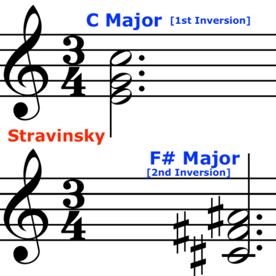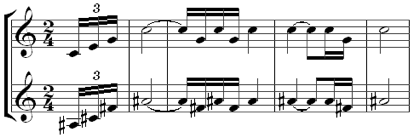Igor Stravinsky
(1882-1971)
STRAVINSKY’S THREE PERIODS

PHASE ONE
Stravinsky’s Russian Period can be divided into two phases: PHASE ONE (1908-1912) and PHASE TWO (1913-1920). The very early period beginning in 1908 put Stravinsky on the map and included the composition that gained him international recognition: his 1910 ballet The Firebird. In 1908 he composed two important works that would help propel him to recognition and his collaboration with the Russian ballet impresario Sergei Diaghilev: Scherzo fantastique (op. 3) and Fireworks (op. 4). These two orchestral works point toward The Firebird and are characterized by the use of exoticism that was prevalent in the works of his teacher Rimsky-Korsakov (Scheherazade, for instance). Check out the wonderful video below of the 4-minute-long Fireworks and notice a few things:
- the interplay and combining of DIATONIC and CHROMATIC music
- the brilliant orchestration - (thank you, Rimsky-Korsakov!)
- the use of OCTATONIC harmony— i.e. based on the OCTATONIC scale:

Of course, one of THE major works of this PHASE ONE Russian Period is The Firebird (1910)—see PROGRAM NOTES AND COMMENTARY for a detailed description of this remarkable composition and how it is put together. For your listening enjoyment, I offer here an amazing video of the Baltic Sea Philharmonic performing—COMPLETELY FROM MEMORY!!!—the Finale from the 1945 version of the Suite (notice the very different ending in terms of note length and bowing in the strings!). Can CYS play the entire Firebird from memory on tour? :)
The other major work of the PHASE ONE Russian Period is Stravinsky’s second ballet for the Ballets Russes: Petrouchka (1911). Petrouchka is a much more complex work than The Firebird and shows Stravinsky beginning to utilize techniques that would characterize much of his work until the NeoClassic phase sets in (1920). These include:
- Bitonality (two keys heard simultaneously, as in the famous “Petrouchka Chord” see below:
- Polymetric music (two different time signatures heard simultaneously)
- Greater use of folk-based tunes and melodies (Russian, Ukrainian, Lithuanian)
- Continued use of chromatic music for “magical” world (puppets) and diatonic music for the “real” world of humans
- Diatonic saturation (enriching triads with other notes from the diatonic scale). Example below from the Russian Dance in Petrouchka.
- Use of small ‘cells’ or musical motives to generate the entire piece



Stravinsky: Petrouchka—Russian Dance from Tableaux 1. The Bolshoi Ballet
PHASE TWO
PHASE TWO of the Russian Period begins with The Rite of Spring (1913) and leads into the second major period of Stravinsky’s output: the NeoClassic Period. Characteristics of this PHASE TWO music include:
- Intensive use of Russian folklore
- Experimentation with smaller instrumental forces (WW I played a large part in this: fewer resources available, and Stravinsky was in self-imposed exile in Switzerland). Note that prior to this time, the majority of Stravinsky’s important works were large-scale orchestral works.
- A move toward more diatonic music
- Use of jazz-inflected harmonies and rhythms (influx of American soldiers into Western Europe at the end of World War I??)
Let’s begin with an excerpt from The Rite of Spring. In many ways, this work was the culmination of Stravinsky’s experimentation with complex harmonies/bitonality and rhythmic displacement/metric changes. It still sounds as fresh and wild today as it did 111 years ago at the epochal premiere performance in Paris!
Stravinsky: Rite of Spring (Dance of Adolescents) —Mariinsky Ballet conducted by Gergiev
In the period between 1914 and 1920, Stravinsky wrote a fair amount of music, much of which was written for smaller groups of musicians than a large symphony orchestra. The outbreak of World War I in 1914 and Stravinsky’s self-imposed exile from Russia in 1915 (he moved to Switzerland) were major factors in his works being reduced to smaller forces. He was also experimenting with ideas that had begun to percolate in his mind with The Rite of Spring one year earlier. Below is a video of the first movement of his Three Pieces for String Quartet. This is unlike anything heard above! This first ‘dance’ immediately sounds rustic, like busking street performers, not only in the violin’s more fiddle-like sound, but in the drone from the viola, the raspy downward figure from second violin, and the plucked cello. It basically breaks all of the ‘rules’ of string quartet writing. It is four individual players doing their own ‘thing’.
Stravinsky: Three Pieces for String Quartet (1914) — The Quartet Berlin-Tokyo
Stravinsky also experimented with ragtime and jazz during this period. Stravinsky wrote that the 5-minute work “is indicative of the passion I felt at the time for jazz, which burst into life so suddenly when the war ended.” His Ragtime for 11 Instruments is a bouncy and upbeat work that features the Hungarian cymbalom (you can’t miss it while watching).
Stravinsky: Ragtime for 11 Instruments (1918) — Orchestre Lamoureux
One of Stravinsky’s most important (and popular) works is from this Russian Period: his “Soldiers Tale” (L’Histoire du soldat), composed in 1918. This work calls for 7 instrumentalists, narrator, and dancers. It tells the story of Joseph the soldier, who sells his soul (the violin) to the devil and winds up…well, we know where that would be. This has always been one of my favorite works to both play (terribly difficult violin part) and conduct (not so easy here, either!). Enjoy the excerpt!
Stravinsky: The Soldier’s Tale (1918) New England Conservatory players

The “Neoclassic” Period of Stravinsky accounts for the longest time period in the composer’s life-32 years-as well as containing the largest number of works (by far) composed in any of the three periods. Stravinsky composed around 110 works in his life, and 42 of them were composed in this Neoclassic period. Most of his large-scale works are also from this period. The composer moved to Paris in 1920 and the period starts with his wonderful and refreshing ballet Pulcinella. According to author Martha Hyde, “Neoclassicism involves an impulse to revive or restore an earlier style that is separated from the present by some intervening period. The Neoclassic aesthetic thus reaches across a cultural and chronological gap and tries to recover or revive a past model.” In his Neoclassical Period Stravinsky either borrows musical material from earlier composers or freely creates completely new music in the Neoclassic style . The chief tenets of musical Neoclassicism are:
- Anti-Romantic: the basic musical aesthetic and ideas are all reactions against late Romantic excesses.
- Revival of absolute forms such as Symphony, Concerto, Suite, Sonata, Fugue, Divertimento, Concerto Grosso, etc.
- New concept of melody: Romantic era melody had largely been vocal melody. Neoclassicism turns toward instrumental melody.
- Music turns away from the chromaticism of Romantic era music toward diatonic or “pan-diatonic” music.
- Texture: VERY IMPORTANT!! Turns away from massive sonorities and toward transparent, linear texture. Clarity emphasized.
- Rhythm: Become less complex than “Rite of Spring” rhythms
Offered here are two examples of the two types of Neoclassicism that Stravinsky made use of: the first makes use of pre-existing music (in this case music by Pergolesi) which is ‘spiced up’ with some interesting additions to the harmony, plus some nice rhythmic twists, and the second is an example of a work that is totally Stravinsky’s own creation—hence a little more complex. Enjoy! Pulcinella has always been one of my favorite works by Stravinsky. It is amazing to think that this was written by the composer of The Rite of Spring! Quite a difference. As for Stravinsky’s Symphony in Three Movements, it is one of his masterpieces of this period. Be sure to check out the section that begins at 00:50 in this piece. Jazzy!
Stravinsky: Pulcinella ballet (1920)
Stravinsky: Symphony in Three Movements (1945)

The year 1951 was a critical year for Stravinsky. In this year he completed his operatic masterpiece and final Neoclassic work: The Rake’s Progress. This was also the year in which Arnold Schoenberg, the great Austrian composer who had composed the first atonal piece of music in 1908 and developed the 12-tone serial method of composing in the early 1920s died in Los Angeles, not far from where Stravinsky lived. Stravinsky and Schoenberg had been less than friendly to each other over the long course of their careers, as they had radically different approaches to what course they believed contemporary music should take.
This fact makes it all the more remarkable that shortly after Schoenberg’s death, Stravinsky began to take an interest in the serial method of composing with ordered sets of notes (“rows”). It remains one of the great mysteries of 20th century music history. Why Stravinsky, and why THEN? For the final 17 years of Stravinsky’s composing life (1951-1968) he would move toward Schoenberg’s method and make something Stravinsky-esque of it.
There is not a lot of music composed at this point in career, as he was hard upon 70 years old and slowing down a bit. Still, he created some amazing music at this late period in his life. Offered here are two brilliant examples of the “serial” Stravinsky. It is worlds apart from his Neoclassic style, but one thing remains absolutely constant in the music of Stravinsky: the primacy of rhythm.
Stravinsky: Movements for Piano and Orchestra (1958-59)
Stravinsky: Requiem Canticles (1965-66)
Lorem ipsum dolor sit amet, consectetur adipiscing elit. Aliquam tincidunt lorem enim, eget fringilla turpis congue vitae. Phasellus aliquam nisi ut lorem vestibulum eleifend. Nulla